Spatial Distribution of Ammonia Concentrations and Modeled Dry Deposition in an Intensive Dairy Production Region
Abstract
:1. Introduction
2. Materials and Methods
2.1. Study and Site Descriptions
2.2. Sampler Preparation, Analyses and Laboratory Comparison
2.3. Modeling
2.4. Description of the STAGE Model
2.5. Model Configuration
2.6. Hourly NH3 Concentrations
2.7. Meteorology
2.8. Land Use and Leaf Area Index
2.9. Vegetation and Soil Emission Potentials
3. Results and Discussion
3.1. Ambient Ammonia Concentrations
3.2. Ammonia Dry Deposition
3.3. Key Model Sensitivities
3.4. Comparison of In-Situ and CMAQ Air Concentrations and Deposition
4. Conclusions
Author Contributions
Funding
Institutional Review Board Statement
Informed Consent Statement
Data Availability Statement
Acknowledgments
Conflicts of Interest
References
- USEPA. 2020 NEI Supporting Data and Summaries; United States Environmental Protection Agency: Washington, DC, USA, 2020.
- Theobald, M.R.; Bealey, W.J.; Tang, Y.S.; Vallejo, A.; Sutton, M.A. A simple model for screening the local impacts of atmospheric ammonia. Sci. Total Environ. 2009, 407, 6024–6033. [Google Scholar] [CrossRef] [PubMed]
- Kelleghan, D.B.; Hayes, E.T.; Everard, M.; Curran, T.P. Predicting atmospheric ammonia dispersion and potential ecological effects using monitored emission rates from an intensive laying hen facility in Ireland. Atmos. Environ. 2021, 247, 118214. [Google Scholar] [CrossRef]
- Stevens, C.J.; Tilman, D. Point source ammonia emissions are having a detrimental impact on prairie vegetation. Water Air Soil Pollut. 2010, 211, 435–441. [Google Scholar] [CrossRef]
- Walker, J.T.; Beachley, G.; Amos, H.M.; Baron, J.S.; Bash, J.; Baumgardner, R.; Bell, M.D.; Benedict, K.B.; Chen, X.; Clow, D.W.; et al. Toward the improvement of total nitrogen deposition budgets in the United States. Sci. Total. Environ. 2019, 691, 1328–1352. [Google Scholar] [CrossRef] [PubMed]
- Allen, A.G.; Harrison, R.M.; Wake, M.T. A meso-scale study of the behaviour of atmospheric ammonia and ammonium. Atmos. Environ. 1967 1988, 22, 1347–1353. [Google Scholar] [CrossRef]
- Baker, J.; Battye, W.H.; Robarge, W.; Pal Arya, S.; Aneja, V.P. Modeling and measurements of ammonia from poultry operations: Their emissions, transport, and deposition in the Chesapeake Bay. Sci. Total Environ. 2020, 706, 135290. [Google Scholar] [CrossRef] [PubMed]
- Pleim, J.E.; Ran, L.; Appel, W.; Shephard, M.W.; Cady-Pereira, K. New bidirectional ammonia flux model in an air quality model coupled with an agricultural model. J. Adv. Model. Earth Syst. 2019, 11, 2934–2957. [Google Scholar] [CrossRef] [PubMed]
- USDA-ERS. Dairy Production Background; USDA: Washington, DC, USA, 2022.
- USDA-NASS. Idaho Statistics; USDA: Washington, DC, USA, 2023.
- Leytem, A.B.; Williams, P.; Zuidema, S.; Martinez, A.; Chong, Y.L.; Vincent, A.; Vincent, A.; Cronan, D.; Kliskey, A.; Wulfhorst, J.D.; et al. Cycling phosphorus and nitrogen through cropping systems in an intensive dairy production region. Agronomy 2021, 11, 1005. [Google Scholar] [CrossRef]
- Pardo, L.H.; Fenn, M.E.; Goodale, C.L.; Geiser, L.H.; Driscoll, C.T.; Allen, E.B.; Baron, J.S.; Bobbink, R.; Bowman, W.D.; Clark, C.M.; et al. Effects of nitrogen deposition and empirical nitrogen critical loads for ecoregions of the United States. Ecol. Appl. 2011, 21, 3049–3082. [Google Scholar] [CrossRef]
- Walker, J.T.; Beachley, G.; Zhang, L.; Benedict, K.B.; Sive, B.C.; Schwede, D.B. A review of measurements of air-surface exchange of reactive nitrogen in natural ecosystems across North America. Sci. Total Environ. 2020, 698, 133975. [Google Scholar] [CrossRef]
- Nemitz, E.; Milford, C.; Sutton, M. A two-layer canopy compensation point model for describing bi-directional biosphere-atmosphere exchange of ammonia. Q. J. R. Meteorol. Soc. 2001, 127, 815–833. [Google Scholar] [CrossRef]
- Zhang, L.; Wright, L.P.; Asman, W.A.H. Bi-directional air-surface exchange of atmospheric ammonia: A review of measurements and a development of a big-leaf model for applications in regional-scale air-quality models. J. Geophys. Res. Atmos. 2010, 115, D20. [Google Scholar] [CrossRef]
- Pleim, J.E.; Bash, J.O.; Walker, J.T.; Cooter, E.J. Development and evaluation of an ammonia bidirectional flux parameterization for air quality models. J. Geophys. Res. Atmos. 2013, 118, 3794–3806. [Google Scholar] [CrossRef]
- Appel, K.W.; Bash, J.O.; Fahey, K.M.; Foley, K.M.; Gilliam, R.C.; Hogrefe, C.; Hutzell, W.T.; Kang, D.; Mathur, R.; Murphy, B.N.; et al. The Community Multiscale Air Quality (CMAQ) model versions 5.3 and 5.3.1: System updates and evaluation. Geosci. Model Dev. 2021, 14, 2867–2897. [Google Scholar] [CrossRef] [PubMed]
- Lee, H.M.; Paulot, F.; Henze, D.K.; Travis, K.; Jacob, D.J.; Pardo, L.H.; Schichtel, B.A. Sources of nitrogen deposition in Federal Class I areas in the US. Atmos. Chem. Phys. 2016, 16, 525–540. [Google Scholar] [CrossRef]
- Clark, C.M.; Phelan, J.; Doraiswamy, P.; Buckley, J.; Cajka, J.C.; Dennis, R.L.; Lynch, J.; Nolte, C.G.; Spero, T.L. Atmospheric deposition and exceedances of critical loads from 1800−2025 for the conterminous United States. Ecol. Appl. 2018, 28, 978–1002. [Google Scholar] [CrossRef]
- Benish, S.E.; Bash, J.O.; Foley, K.M.; Appel, K.W.; Hogrefe, C.; Gilliam, R.; Pouliot, G. Long-term regional trends of nitrogen and sulfur deposition in the United States from 2002 to 2017. Atmos. Chem. Phys. 2022, 22, 12749–12767. [Google Scholar] [CrossRef]
- Makar, P.A.; Akingunola, A.; Aherne, J.; Cole, A.S.; Aklilu, Y.A.; Zhang, J.; Wong, I.; Hayden, K.; Li, S.M.; Kirk, J.; et al. Estimates of exceedances of critical loads for acidifying deposition in Alberta and Saskatchewan. Atmos. Chem. Phys. 2018, 18, 9897–9927. [Google Scholar] [CrossRef]
- Zhang, L.; Vet, R.; O’Brien, J.; Mihele, C.; Liang, Z.; Wiebe, A. Dry deposition of individual nitrogen species at eight Canadian rural sites. J. Geophys. Res. 2009, 114, D02301. [Google Scholar] [CrossRef]
- Flechard, C.R.; Nemitz, E.; Smith, R.I.; Fowler, D.; Vermeulen, A.T.; Bleeker, A.; Erisman, J.W.; Simpson, D.; Zhang, L.; Tang, Y.S.; et al. Dry deposition of reactive nitrogen to European ecosystems: A comparison of inferential models across the NitroEurope network. Atmos. Chem. Phys. 2011, 11, 2703–2728. [Google Scholar] [CrossRef]
- Sigma-Aldrich. Radiello Manual, Sigma-Aldrich: St. Louis, MO, USA.
- Clifton, O.E.; Schwede, D.; Hogrefe, C.; Bash, J.O.; Bland, S.; Cheung, P.; Coyle, M.; Emberson, L.; Flemming, J.; Fredj, E.; et al. A single-point modeling approach for the intercomparison and evaluation of ozone dry deposition across chemical transport models (Activity 2 of AQMEII4). Atmos. Chem. Phys. 2023, 23, 9911–9961. [Google Scholar] [CrossRef] [PubMed]
- Walker, J.T.; Chen, X.; Wu, Z.; Schwede, D.; Daly, R.; Djurkovic, A.; Oishi, A.C.; Edgerton, E.; Bash, J.; Knoepp, J.; et al. Atmospheric deposition of reactive nitrogen to a deciduous forest in the southern Appalachian Mountains. Biogeosciences 2023, 20, 971–995. [Google Scholar] [CrossRef]
- Massad, R.S.; Nemitz, E.; Sutton, M.A. Review and parameterisation of bi-directional ammonia exchange between vegetation and the atmosphere. Atmos. Chem. Phys. 2010, 10, 10359–10386. [Google Scholar] [CrossRef]
- Søren, H.; Jan Kofod, S. Apoplastic pH and Ammonium Concentration in Leaves of Brassica napus L. Plant Physiol. 1995, 109, 1453–1460. [Google Scholar]
- Foley, K.M.; Pouliot, G.A.; Eyth, A.; Aldridge, M.F.; Allen, C.; Appel, K.W.; Bash, J.O.; Beardsley, M.; Beidler, J.; Choi, D.; et al. 2002–2017 anthropogenic emissions data for air quality modeling over the United States. Data Brief 2023, 47, 109022. [Google Scholar] [CrossRef]
- Chen, F.; Dudhia, J. Coupling an advanced land surface-hydrology model with the Penn State-NCAR MM5 modeling system. part I, model implementation and sensitivity. Mon. Weather. Rev. 2001, 129, 569–585. [Google Scholar] [CrossRef]
- Chen, F.; Janjic, Z.; Mitchell, K. Impact of atmospheric surface layer parameterization in the new land-surfaces cheme of the NCEP mesoscale Eta numerical model. Bound. Layer Meteorol. 1997, 185, 391–421. [Google Scholar] [CrossRef]
- Walker, J.; Daly, R.; Djurkovic, A.; Barnes, M.; Baumgardner, R.; Macy, T.; Puchalski, M.; Isil, S.; Mishoe, K.; Stewart, M.; et al. AMoN Site Characterization Study for NH3 Bidirectional Flux Modeling: Phase I Field Measurements; U.S. Environmental Protection Agency: Washington, DC, USA, 2023.
- Vogeler, I.; Cichota, R.; Snow, V.O.; Dutton, T.; Daly, B. Pedotransfer functions for estimating ammonium adsorption in soils. Soil Sci. Soc. Am. J. 2011, 75, 324–331. [Google Scholar] [CrossRef]
- Venterea, R.T.; Clough, T.J.; Coulter, J.A.; Breuillin-Sessoms, F.; Wang, P.; Sadowsky, M.J. Ammonium sorption and ammonia inhibition of nitrite-oxidizing bacteria explain contrasting soil N2O production. Sci. Rep. 2015, 5, 12153. [Google Scholar] [CrossRef]
- Hinz, C. Description of sorption data with isotherm equations. Geoderma 2001, 99, 225–243. [Google Scholar] [CrossRef]
- Sieczka, A.; Koda, E. Kinetic and equilibrium studies of sorption of ammonium in the soil-water environment in agricultural areas of central poland. Appl. Sci. 2016, 6, 296. [Google Scholar] [CrossRef]
- Liu, Y.; Shen, L. From langmuir kinetics to first- and second-order rate equations for adsorption. Langmuir 2008, 24, 11625–11630. [Google Scholar] [CrossRef] [PubMed]
- Cooter, E.J.; Bash, J.O.; Benson, V.; Ran, L. Linking agricultural crop management and air quality models for regional to national-scale nitrogen assessments. Biogeosciences 2012, 9, 4023–4035. [Google Scholar] [CrossRef]
- Williams, J.R. The EPIC model. In Computer Models of Watershed Hydrology; Singh, V.P., Ed.; Water Resources Publ.: Highlands Ranch, CO, USA, 1995; pp. 909–1000. [Google Scholar]
- Bash, J.O.; Cooter, E.J.; Dennis, R.L.; Walker, J.T.; Pleim, J.E. Evaluation of a regional air-quality model with bidirectional NH3 exchange coupled to an agroecosystem model. Biogeosciences 2013, 10, 1635–1645. [Google Scholar] [CrossRef]
- Liu, P.; Ding, J.; Ji, Y.; Xu, H.; Liu, S.; Xiao, B.; Jin, H.; Zhong, X.; Guo, Z.; Wang, H.; et al. Satellite support to estimate livestock ammonia emissions: A Case Study in Hebei, China. Atmosphere 2022, 13, 1552. [Google Scholar] [CrossRef]
- Saha, C.K.; Ammon, C.; Berg, W.; Fiedler, M.; Loebsin, C.; Sanftleben, P.; Brunsch, R.; Amon, T. Seasonal and diel variations of ammonia and methane emissions from a naturally ventilated dairy building and the associated factors influencing emissions. Sci. Total Environ. 2014, 468–469, 53–62. [Google Scholar] [CrossRef]
- Mielcarek-Bocheńska, P.; Rzeźnik, W. Ammonia emission from livestock production in Poland and its regional diversity, in the years 2005–2017. Arch. Environ. Prot. 2019, 45, 114–121. [Google Scholar] [CrossRef]
- Souhar, O.; Fauvel, Y.; Flechard, C. Measuring and modeling atmospheric ammonia from agricultural sources at a landscape scale. Environ. Eng. Sci. 2022, 39, 673–684. [Google Scholar] [CrossRef]
- Walker, J.; Spence, P.; Kimbrough, S.; Robarge, W. Inferential model estimates of ammonia dry deposition in the vicinity of a swine production facility. Atmos. Environ. 2008, 42, 3407–3418. [Google Scholar] [CrossRef]
- Cassel, T.; Ashbaugh, L.; Flocchini, R. Ammonia flux from open-lot dairies: Development of measurement methodology and emission factors. J. Air Waste Manag. Assoc. 2005, 55, 816–825. [Google Scholar] [CrossRef]
- Grant, R.H.; Boehm, M.T.; Heber, A.J. Ammonia emissions from anaerobic waste lagoons at pork production operations: Influence of climate. Agric. For. Meteorol. 2016, 228–229, 73–84. [Google Scholar] [CrossRef]
- Guo, H.; Hao, H.; Zhang, Q.; Wang, J.; Liu, J. Components and dispersion characteristics of organic and inorganic odorous gases in a large-scale dairy farm. J. Air Waste Manag. Assoc. 2019, 69, 717–725. [Google Scholar] [CrossRef] [PubMed]
- Lovanh, N.; Quintanar, A.; Rysz, M.; Loughrin, J.; Mahmood, R. Effect of Heat Fluxes on Ammonia Emission from Swine Waste Lagoon Based on Neural Network Analyses. J. Environ. Sci. Technol. 2014, 7, 16–29. [Google Scholar] [CrossRef]
- Wu, C.; Yang, F.; Brancher, M.; Liu, J.; Qu, C.; Piringer, M.; Schauberger, G. Determination of ammonia and hydrogen sulfide emissions from a commercial dairy farm with an exercise yard and the health-related impact for residents. Environ. Sci. Pollut. Res. 2020, 27, 37684–37698. [Google Scholar] [CrossRef] [PubMed]
- Hojito, M.; Hayashi, K.; Matsuura, S. net Ammonia exchange on grasslands in an intensive dairying region in central Japan. Soil Sci. Plant Nutr. 2010, 56, 503–511. [Google Scholar] [CrossRef]
- Van Hove, L.W.A.; Adema, E.H.; Vredenberg, W.J.; Pieters, G.A. A study of the adsorption of NH3 and SO2 on leaf surfaces. Atmos. Environ. 1967 1989, 23, 1479–1486. [Google Scholar] [CrossRef]
- Schwede, D.B.; Lear, G.G. A novel hybrid approach for estimating total deposition in the United States. Atmos. Environ. 2014, 92, 207–220. [Google Scholar] [CrossRef]
- Zhu, S.; Wu, K.; Nizkorodov, S.A.; Dabdub, D. Modeling reactive ammonia uptake by secondary organic aerosol in a changing climate: A WRF-CMAQ evaluation. Front. Environ. Sci. 2022, 10, 310. [Google Scholar] [CrossRef]
- Zhang, R.; Thompson, T.M.; Barna, M.G.; Hand, J.L.; McMurray, J.A.; Bell, M.D.; Malm, W.C.; Schichtel, B.A. Source regions contributing to excess reactive nitrogen deposition in the Greater Yellowstone Area (GYA) of the United States. Atmos. Chem. Phys. 2018, 18, 12991–13011. [Google Scholar] [CrossRef]
- Allen, E.B.; Rao, L.E.; Steers, R.J.; Bytnerowicz, A.; Fenn, M.E. Impacts of atmospheric nitrogen deposition on vegetation and soils in Joshua Tree National Park. In The Mojave Desert: Ecosystem Processes and Sustainability; Webb, R.H., Fenstermaker, L.F., Heaton, J.S., Hughson, D.L., McDonald, E.V., Miller, D.M., Eds.; University of Nevada Press: Las Vegas, NV, USA, 2009; pp. 78–100. [Google Scholar]
- Inouye, R. Effects of shrub removal and nitrogen addition on soil moisture in sagebrush steppe. J. Arid. Environ. 2006, 65, 604–618. [Google Scholar] [CrossRef]
- Balch, J.K.; Bradley, B.A.; D’Antonio, C.M.; Gómez-Dans, J. Introduced annual grass increases regional fire activity across the arid western USA (1980–2009). Glob. Chang. Biol. 2013, 19, 173–183. [Google Scholar] [CrossRef] [PubMed]
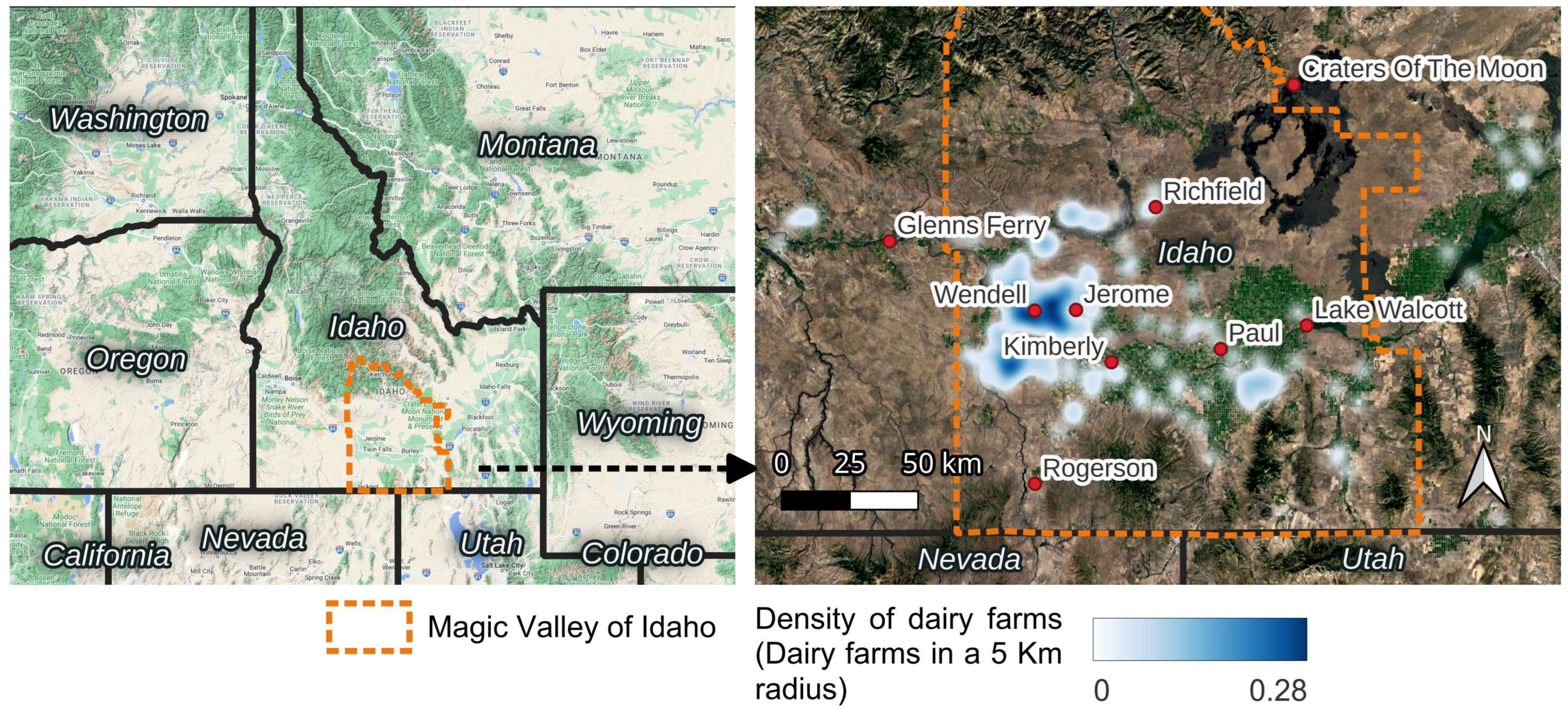
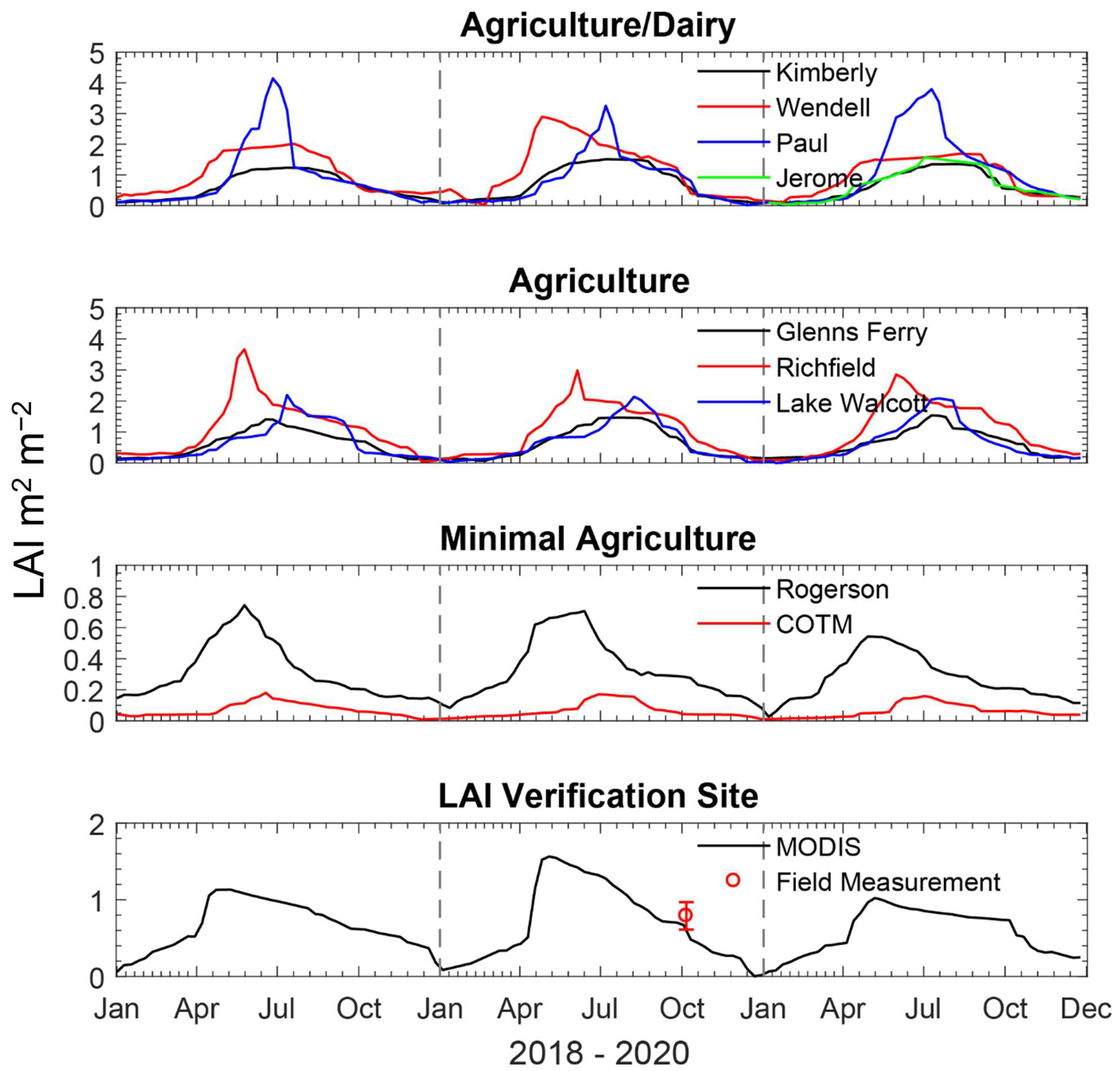
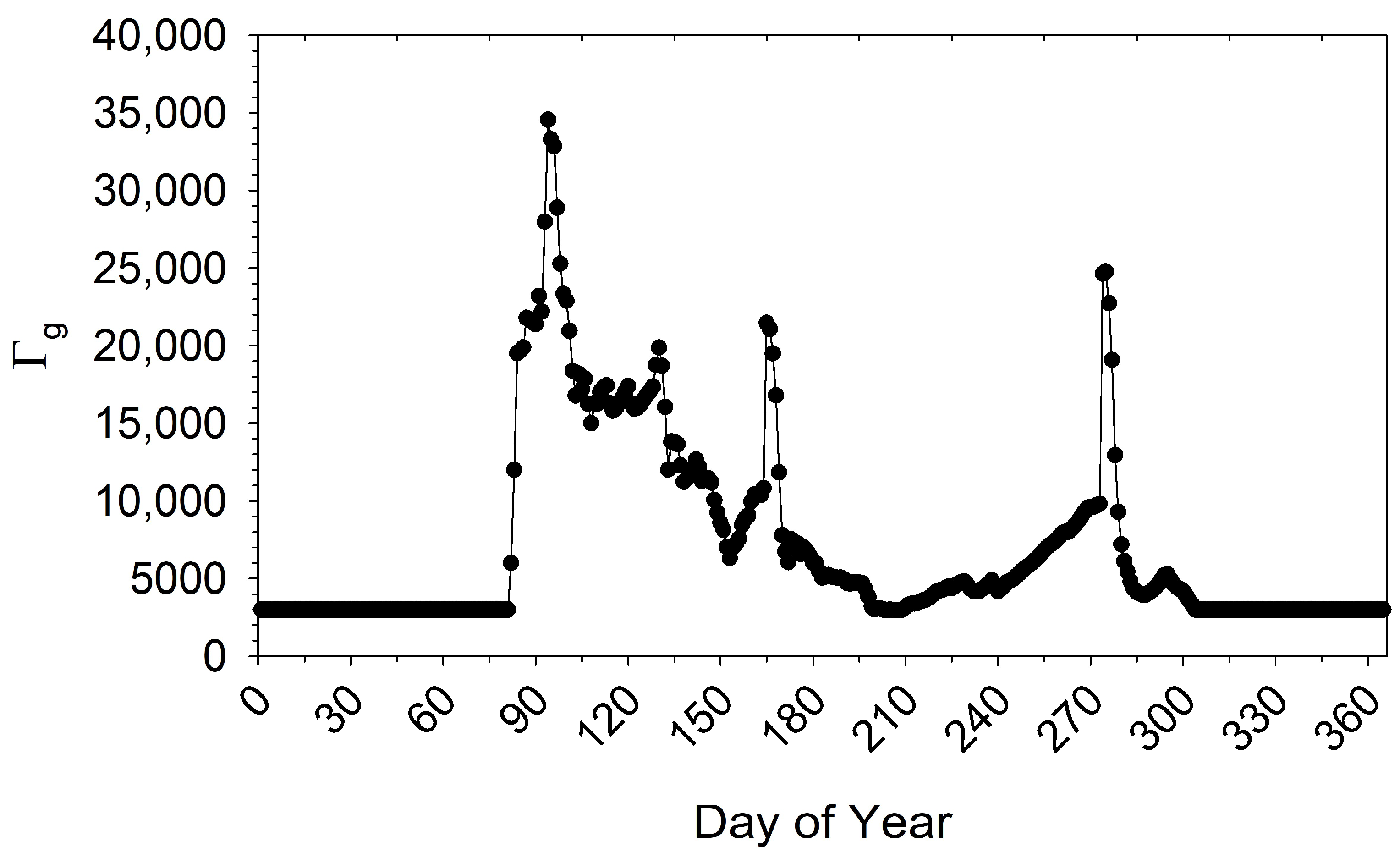
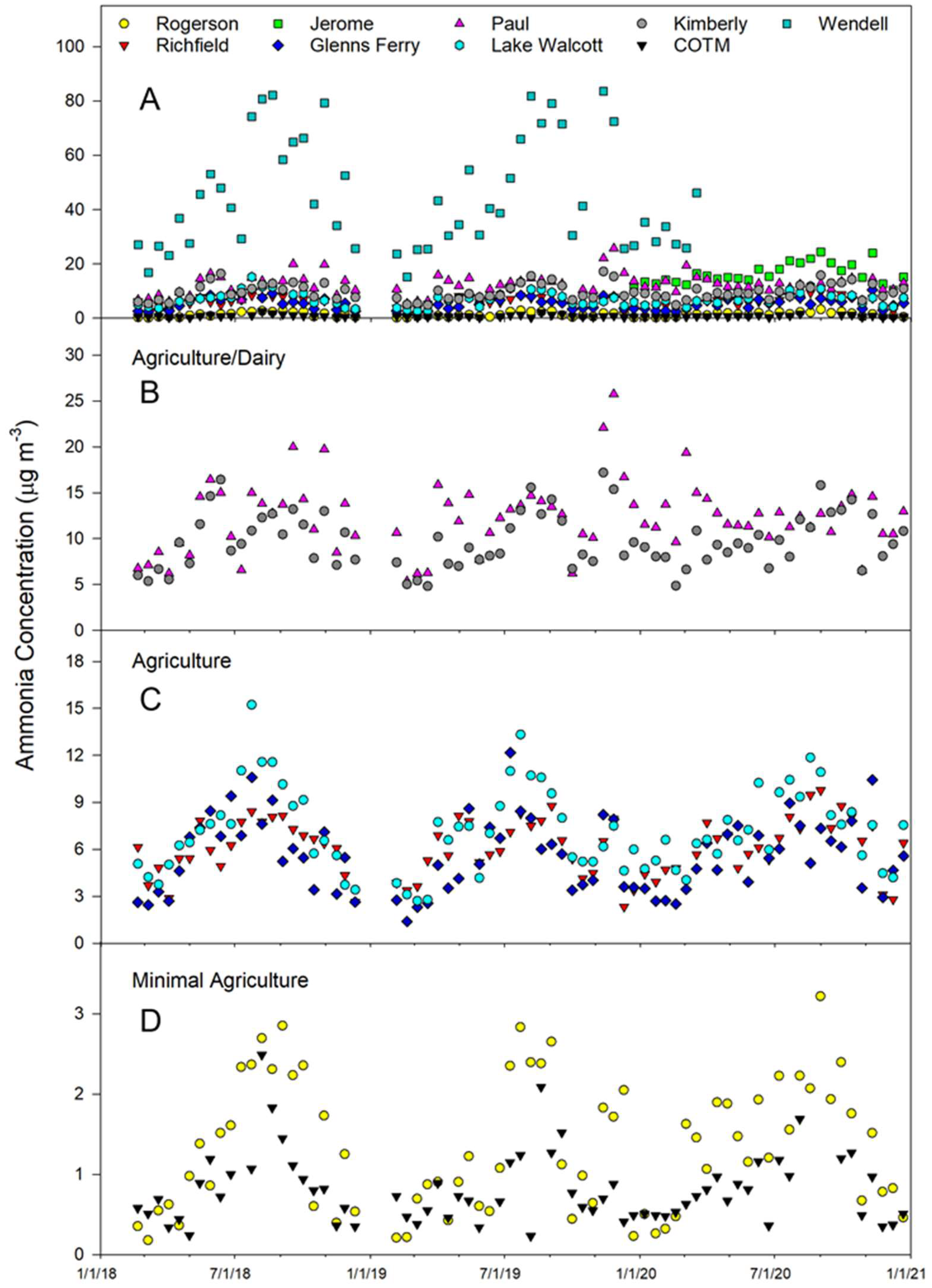
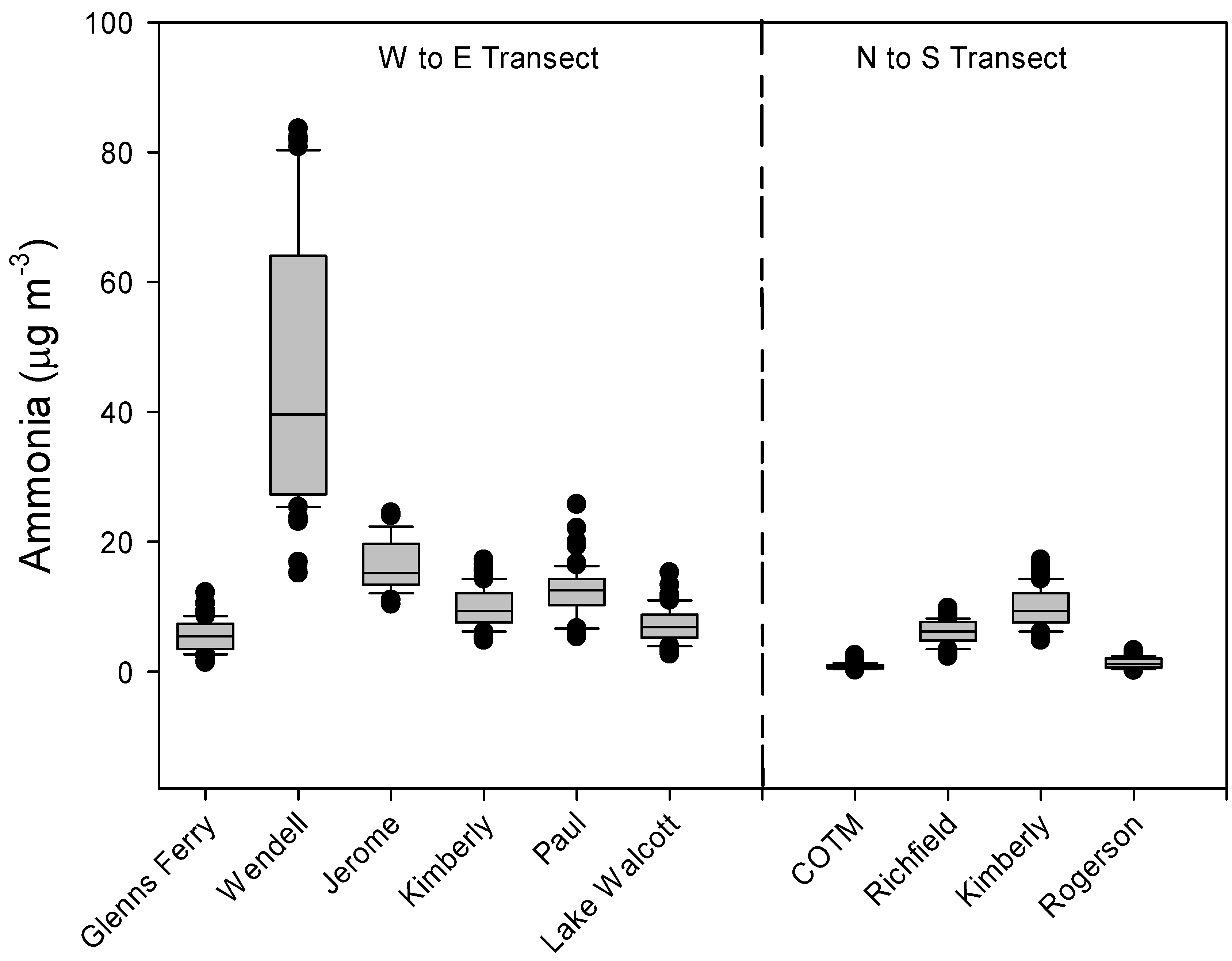
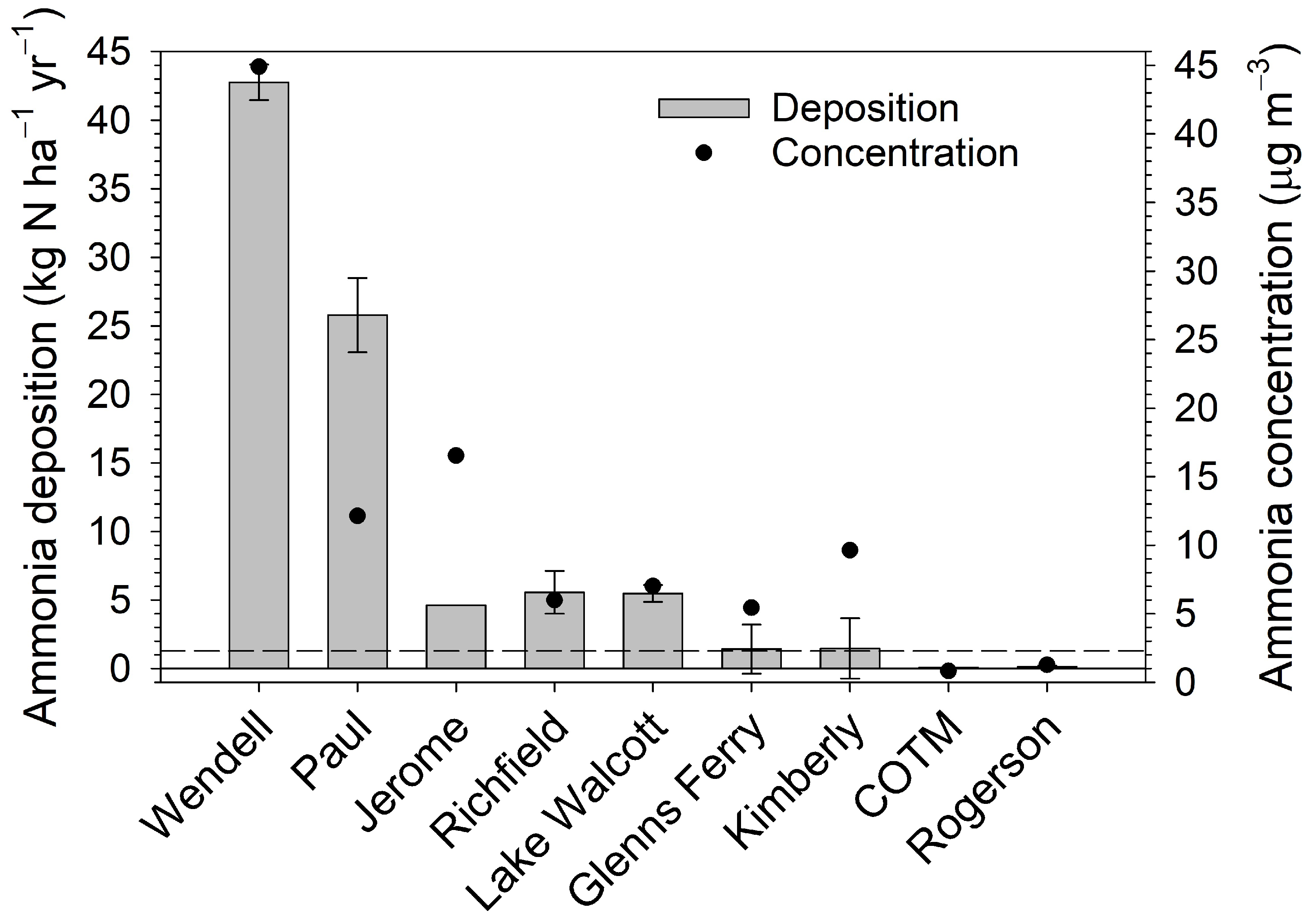

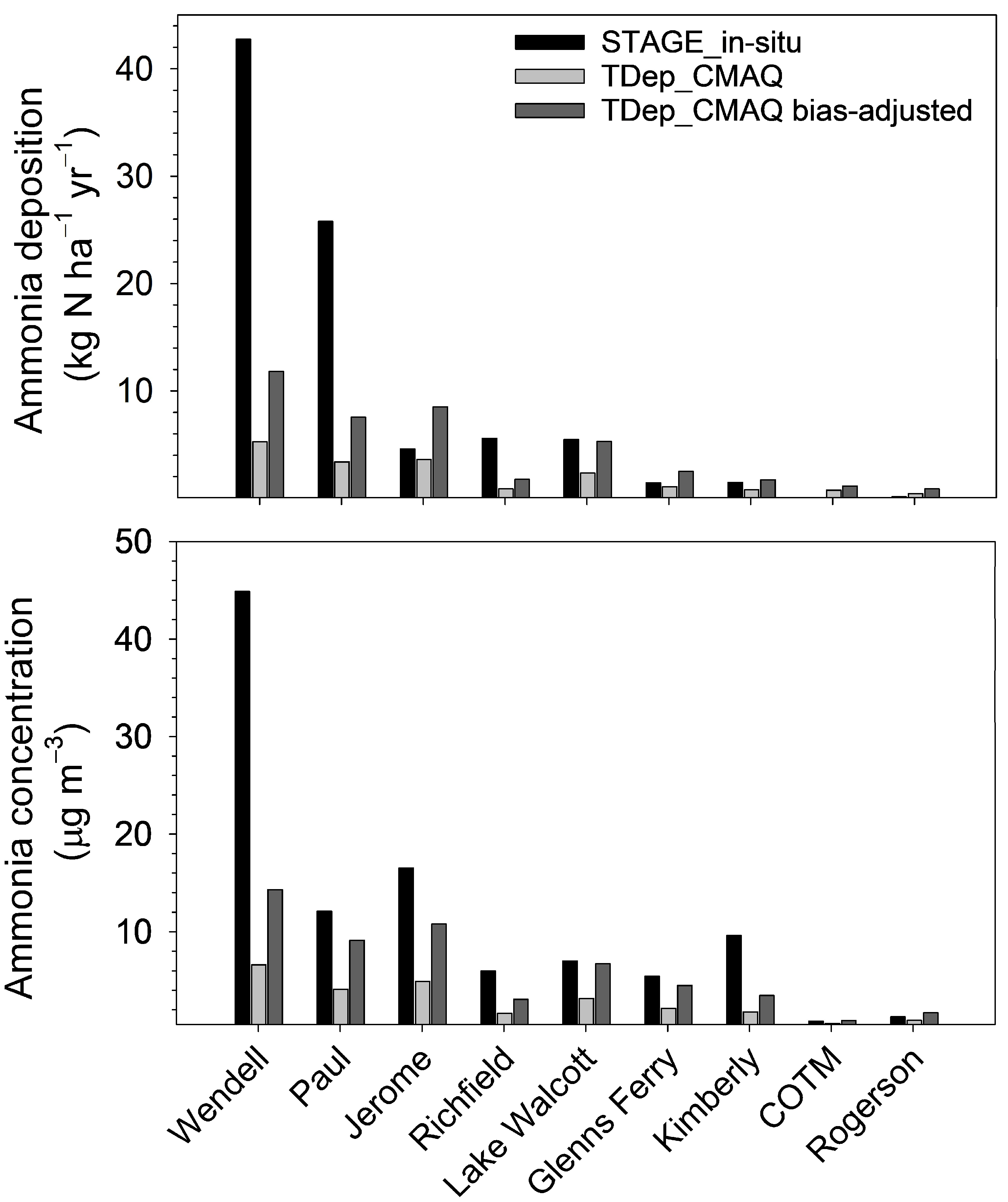
| ID | Site Name | Latitude | Longitude | Elevation | Deployment Dates | Site Type | Site Description |
|---|---|---|---|---|---|---|---|
| Decimal Degrees | m | ||||||
| COTM | COTM | 43.44784 | −113.55174 | 1798 | 2/5/2018–12/22/2020 | Minimal agriculture | Lava fields, sagebrush steppe |
| GF | Glenns Ferry | 42.94426 | −115.33367 | 772 | 2/5/2018–12/22/2020 | Agriculture | Irrigated agriculture, sagebrush steppe |
| JE | Jerome | 42.72248 | −114.51163 | 1159 | 12/23/2019–12/22/2020 | Agriculture/dairy | Moderate density dairy, urban |
| KI | Kimberly | 42.55297 | −114.35493 | 1185 | 2/5/2018–12/22/2020 | Agriculture/dairy | Irrigated agriculture, few dairies |
| LW | Lake Walcott | 42.67184 | −113.49472 | 1266 | 2/5/2018–12/22/2020 | Agriculture | Sagebrush steppe, some irrigated agriculture |
| PA | Paul | 42.59545 | −113.87393 | 1281 | 2/5/2018–12/22/2020 | Agriculture/dairy | Irrigated agriculture, some dairy |
| RI | Richfield | 43.05461 | −114.16023 | 1317 | 2/5/2018–12/22/2020 | Agriculture | Irrigated agriculture, some dairy |
| RO | Rogerson | 42.15674 | −114.69247 | 1607 | 2/5/2018–12/22/2020 | Minimal agriculture | Sagebrush steppe |
| WE | Wendell | 42.72 | −114.69366 | 1034 | 2/5/2018–3/17/2020 | Intensive dairy | High-density dairy, irrigated agriculture |
| Site | Land Use Type (Fraction) | Γs | Γg |
|---|---|---|---|
| Glenns Ferry | Croplands | 4750 | Variable |
| Kimberly | Croplands | 4750 | Variable |
| COTM | Barren or sparsely vegetated (0.87), grasslands (0.13) | 149 | 117 |
| Rogerson | Grasslands | 1145 | 900 |
| Richfield | Grasslands (0.5), croplands (0.5) | 2947 | Variable |
| Wendell | Grasslands (0.8), croplands (0.2) | 1866 | Variable |
| Paul | Croplands | 4750 | Variable |
| Lake Walcott | Grasslands (0.58), croplands (0.42) | 2659 | Variable |
| Jerome | Croplands | 4750 | Variable |
| Site | Meteo. Station (Distance in km) | Ta | RH | WS | Pa | Rg_in | Precip | u* | SW | Tsoil | SM |
|---|---|---|---|---|---|---|---|---|---|---|---|
| Glenns Ferry | GFRI (8.8) | O | O | O | M1 | O | O | M3 | M3 | M3 | M3 |
| Kimberly | TWFI (1.1) | O | O | O | M1 | O | O | M3 | M3 | M3 | M3 |
| COTM | N.A. | M1 | M1 | M1 | M1 | M2 | M2 | M3 | M3 | M3 | M3 |
| Rogerson | N.A. | M1 | M1 | M1 | M1 | M2 | M2 | M3 | M3 | M3 | M3 |
| Richfield | ICHI (2.2) | O | O | O | M1 | O | M2 | M3 | M3 | M3 | M3 |
| Wendell | TFGI (18.4) | O | O | O | M1 | O | O | M3 | M3 | M3 | M3 |
| Paul | RPTI (0.1) | O | O | O | M1 | O | O | M3 | M3 | M3 | M3 |
| Lake Walcott | MDKI (17.3) | O | O | O | O | O | M2 | M3 | M3 | M3 | M3 |
| Jerome | TFGI (18.6) | O | O | O | M1 | O | O | M3 | M3 | M3 | M3 |
| Climatic Variables | ||||||
|---|---|---|---|---|---|---|
| Wind Speed | Air Temperature | Relative Humidity | Soil Temperature 10 cm | Surface Temperature | Solar Radiation | |
| m/s | K | % | K | K | W/m2 | |
| All data | −0.60 | 0.29 | −0.10 | 0.28 | 0.29 | 0.37 |
| <0.0001 | <0.0001 | 0.014 | <0.0001 | <0.0001 | <0.0001 | |
| WE (intensive dairy) | −0.79 | 0.71 | −0.63 | 0.70 | 0.69 | 0.61 |
| <0.0001 | <0.0001 | <0.0001 | <0.0001 | <0.0001 | <0.0001 | |
| Agriculture/dairy | −0.45 | 0.35 | −0.31 | 0.34 | 0.33 | 0.32 |
| <0.0001 | <0.0001 | <0.0001 | <0.0001 | <0.0001 | <0.0001 | |
| Agriculture | −0.20 | 0.70 | −0.66 | 0.71 | 0.71 | 0.62 |
| 0.003 | <0.0001 | <0.0001 | <0.0001 | <0.0001 | <0.0001 | |
| Minimal agriculture | −0.38 | 0.72 | −0.70 | 0.68 | 0.67 | 0.59 |
| <0.0001 | <0.0001 | <0.0001 | <0.0001 | <0.0001 | <0.0001 | |
| % Stomatal | % Cuticular | % Ground | Land Use | |
|---|---|---|---|---|
| Glenns Ferry | 6.9 | 52.0 | 41.1 | Croplands |
| Jerome | 3.5 | 89.5 | 7.0 | Croplands |
| Kimberly | 2.7 | 55.2 | 42.1 | Croplands |
| Paul | 3.4 | 83.6 | 13.0 | Croplands |
| Lake Walcott | 0.3 | 76.3 | 23.4 | Croplands/grasslands |
| Richfield | 2.2 | 71.9 | 25.9 | Croplands/grasslands |
| Wendell | 5.4 | 53.8 | 40.8 | Croplands/grasslands |
| COTM | 1.3 | 5.2 | 93.5 | Grassland/barren |
| Rogerson | 14.1 | 60.6 | 25.3 | Grasslands |
Disclaimer/Publisher’s Note: The statements, opinions and data contained in all publications are solely those of the individual author(s) and contributor(s) and not of MDPI and/or the editor(s). MDPI and/or the editor(s) disclaim responsibility for any injury to people or property resulting from any ideas, methods, instructions or products referred to in the content. |
© 2023 by the authors. Licensee MDPI, Basel, Switzerland. This article is an open access article distributed under the terms and conditions of the Creative Commons Attribution (CC BY) license (https://creativecommons.org/licenses/by/4.0/).
Share and Cite
Leytem, A.B.; Walker, J.T.; Wu, Z.; Nouwakpo, K.; Baublitz, C.; Bash, J.; Beachley, G. Spatial Distribution of Ammonia Concentrations and Modeled Dry Deposition in an Intensive Dairy Production Region. Atmosphere 2024, 15, 15. https://doi.org/10.3390/atmos15010015
Leytem AB, Walker JT, Wu Z, Nouwakpo K, Baublitz C, Bash J, Beachley G. Spatial Distribution of Ammonia Concentrations and Modeled Dry Deposition in an Intensive Dairy Production Region. Atmosphere. 2024; 15(1):15. https://doi.org/10.3390/atmos15010015
Chicago/Turabian StyleLeytem, April B., John T. Walker, Zhiyong Wu, Kossi Nouwakpo, Colleen Baublitz, Jesse Bash, and Gregory Beachley. 2024. "Spatial Distribution of Ammonia Concentrations and Modeled Dry Deposition in an Intensive Dairy Production Region" Atmosphere 15, no. 1: 15. https://doi.org/10.3390/atmos15010015
APA StyleLeytem, A. B., Walker, J. T., Wu, Z., Nouwakpo, K., Baublitz, C., Bash, J., & Beachley, G. (2024). Spatial Distribution of Ammonia Concentrations and Modeled Dry Deposition in an Intensive Dairy Production Region. Atmosphere, 15(1), 15. https://doi.org/10.3390/atmos15010015








